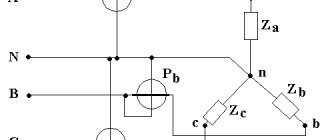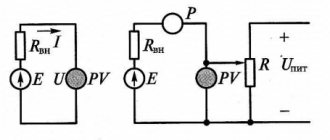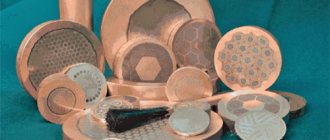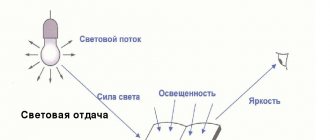Laser diodes LD
The nature of the emitted radiation depends on how photons are generated and emitted from the pn junction. In the case of LEDs, this is incoherent radiation containing waves of different frequencies and therefore different colors. Laser diodes emit coherent and monochromatic radiation in slightly divergent beams, which affects the capabilities and applications of both types of diodes.
As for laser LEDs, they open up opportunities for the production of blue diodes. Blue gallium nitride GaN laser diodes can emit light ranging from ultraviolet to blue (370–500 nm), depending on the chemical composition of the active layer in the semiconductor structure. The threshold voltages at which the laser effect occurs range from 3.8 to 5.5 V, and the threshold current density is in the range of 2–5 kA/cm2.
As with conventional LEDs, white light in laser diodes (LDs) is most often produced using a blue diode and a phosphor. But these diodes provide additional opportunities due to the fact that the phosphor can be installed not only next to the diode crystal in the same housing, but also at some distance from it (LARP - Laser Activated Remote Phosphors systems).
In addition, the phosphor can be applied to a substrate that transmits or reflects the beam. By using these capabilities and the associated optical systems to direct and focus the beam, a variety of lighting colors and geometries can be achieved.
How to connect
A feature of the laser diode is the high need for a stabilized supply voltage. At the moment of transition, a short-term increase in power is observed on the crystal due to the small area, which increases the concentration of energy at a given point. This makes it necessary to use a special stabilizer - a driver.
In addition, the element cannot be connected directly to the driver - it is necessary to use a current-measuring resistor, which is connected to the gap between the laser and the driver. In this case, the electrical connection between the power supply minus and the general minus of the circuit disappears. An additional disadvantage is the inevitable loss of power across the resistor.
Various devices can serve as a source of current for the laser:
- battery;
- battery;
- mains voltage 220 V through a special power supply.
The first two options are capable of providing a fairly stable supply voltage, but it is constantly decreasing, which is also unacceptable. If a standard type power supply is used, the situation improves somewhat, although in this case high-quality protection against breakdown or failure of the unit is needed.
With this connection, additional protection circuits and stabilizers are used to eliminate bursts and interference from network surges. Using a conventional diode bridge is not suitable in this case, since a lot of parasitic oscillations and interference pass through standard rectifiers.
Driver for laser diode
There are two main driver designs for laser diodes:
- impulse. This is one of the types of pulse voltage converter. Capable of working both to decrease and to increase the output voltage relative to the input value. The input power approaches the output, the difference between them is formed by some losses due to heating of the conductors;
- linear. Typically, it receives more voltage from the circuit than the rating of the semiconductor. The difference is usually compensated using a transistor, which releases excess energy in the form of heat. The efficiency of linear drivers is low, which is the reason for their limited use.
Important! For each type of driver, its own connection diagram is used, taking into account the specifics of the driver itself, the power source and the current-limiting resistor.
Superluminescent diodes
A superluminescent diode (SLD or SLED - superluminescent light emitting diode) uses the phenomenon of superluminescence to emit light. Like a laser diode, it has relatively high power and brightness, and at the same time - like a conventional LED - low coherence of the emitted light. In a diode structure, which is similar to the structure used in an LED diode, an optical fiber is made to amplify the light beam, but without reflecting mirrors. Example applications include optical coherence tomography, scanning interferometry, optical sensors, fiber optic gyroscopes, and fiber optic communications.
Varieties
There are quite a few design options for laser diodes. They differ from each other in the location of pn junctions, the configuration of the semiconductor element and other features. The following types exist:
- diode with pn homostructure. One of the first designs that is practically never seen today. Requires high initial power and input signal interruption to prevent overheating;
- with double heterostructure. They are a small-thick crystal enclosed between two additional layers that enhance the flux of photons and expand the active region;
- with quantum wells. They are formed by reducing the middle layer of elements with a double heterostructure. Quantum wells with different energy levels appear, which play the role of a barrier at the pn junction, capable of releasing photons;
- heterostructural elements with separate confinement. Most laser diodes are made using this technology. Its peculiarity is the application of additional layers to a thin central crystal, resulting in the effective formation and concentration of the light beam;
- with feedback distribution. A special notch is made in the area of the pn junction, which ensures the creation of a diffraction grating. This stabilizes the wavelength, resulting in a more stable light beam. They are used in the field of telecommunications, as well as in various types of optical devices;
- VCSEL. This is a laser belonging to the elements of surface radiation. It is equipped with a vertical resonator, thanks to which the direction of the beam changes - while in other types of crystals the light moves parallel to the edges, then in this design it is emitted in a perpendicular direction. There is another modification of such an element - VECSEL. It has an almost similar configuration, only with an external resonator.
Laser diodes for pumping DPSSL solid-state lasers
It is also worth paying attention to the use of laser diodes in devices for producing green, yellow and blue laser radiation. Popular products in this group are indicators, devices for measuring and leveling distances, optical sights, as well as sources of information and warning light.
They also handle precision industrial operations such as drilling and trimming of PCBs and flex printed circuit boards, trimming resistors and cutting ITO boards, to operations, inspections and graphics work, as well as precision marking of products and their micro-machining, including materials such as like glass, silicon, ceramics and metals. Such lasers can also be used in medical and cosmetic surgery.
The initial component of DPSSL devices is a semiconductor GaAlAs laser diode with a power of several hundred mW, emitting an infrared wavelength of 808 nm. This radiation powers (pumps) a laser diode - an Nd: YAG laser, formed on the basis of an yttrium-aluminum garnet crystal doped with neodymium ions (or on the basis of yttrium orthovanadate, also doped with neodymium Nd: YVO4, which provides greater gain and compact design). This laser emits in the near-infrared region with a wavelength of 1064 nm.
The next step is to double the frequency (emphasize the 2nd harmonic) of the emitted wave, reducing its length to 532 nm, which corresponds to the color green. This is achieved by exploiting the nonlinear properties of the crystal, known briefly as KTP. This is potassium titanyl phosphate KO5PTi (or KTiOPO4). Using other materials, such as lithium tribrate LBO or barium beta borate BBO, it is also possible to triple or even quadruple the frequency of the radiation. When yellow light is required, the desired effect is achieved by controlling the wavelengths emitted using crystals from the groups of materials described. But there are other materials in DPSSL devices that emit blue light, such as barium and boron compounds.
Of course, the use of double conversion of emitted wavelengths reduces energy efficiency, but the positive aspect will be the ability to cheaply obtain strong focused beams of radiation of selected colors. Particularly high power levels (on the order of kW) can be achieved with pulsed operation of DPSSL lasers.
Category: Applications
Pulsed laser diodes and avalanche photodiodes for industrial and commercial applications
Authors: Winfried Reeb, Laser Components GmbH
The use of pulsed laser diodes and avalanche photodiodes enables fast, accurate and non-contact distance measurement in a variety of optoelectronic applications. Depending on the requirements for the performance and service life of the system, both single-element and multi-element pulsed laser diodes (stacks) can be used as an emitter, while avalanche photodiodes of different internal structures are used as a photodetector.
Pulsed laser diodes and avalanche photodiodes have their origins in military applications. Due to the peak power of pulsed laser diodes exceeding 200 W and the high sensitivity of avalanche photodiodes, they are ideal for time-of-flight ranging. Advances in technology and cost reductions have opened up new areas of industrial, commercial and automotive applications for these devices.
Pulsed laser diodes
Most laser diodes are designed to operate in continuous wave mode with powers ranging from a few mW to several watts. Such laser diodes cannot be overloaded, because If the supply voltage is exceeded even for a short time, the laser resonator may fail and, as a result, the radiation will stop.
Pulsed laser diodes, on the other hand, are designed to experience power overload for short periods of time. To achieve the maximum peak power required for a particular application, the duty cycle can be very small, typically 0.1%. For example, after a pulse with a duration of 100 ns there is a pause of 100 ms, this means that very short pulses can occur at a repetition rate of kHz. The maximum pulse duration is at the level of several hundred ns. To produce such pulses, laser currents can reach levels of several tens of amperes, which requires the use of fast switching transistors and suitable circuitry with minimal electrical connections to reduce induction losses.
Fig.1. Pulsed laser diodes and avalanche photodiodes from Laser Components in various housing options.
An important criterion for choosing laser diodes is the wavelength of the radiation. First of all, it depends on the material of the active and passive layers of the semiconductor. The following emission wavelengths are available for most commercial applications: 850-870 nm, 905 nm, 1550 nm. The 905 nm AlGaAs laser structure is widely recognized for its reliability, beam quality and temperature stability. High efficiency (about 1 W/A) makes it possible to obtain a peak power of up to 40 W from a single emitter and up to 220 W from a multi-element (several emitters - stacked) laser diode with a pulse duration of 100 ns. With shorter pulse durations, peak power of more than 500 W is achievable. The advantage of the radiation wavelength of 905 nm is that the maximum spectral sensitivity of silicon avalanche photodiodes lies precisely in this region. Laser diodes with a wavelength in the mid-IR region of 1550 nm are available with higher output power compared to 905 nm diodes, however, they are also safe for the human eye due to the fact that the radiation is not focused directly on the retina.
Laser diodes at 1550 nm are based on InP material with additional InGaAs layers, which can be produced either by molecular beam epitaxy or by metal-organic vapor deposition. With an efficiency of 0.35 W/A, the peak output power of multi-element laser diodes can reach 50 W with a pulse duration of 150 ns. Due to the need for a heat sink, these laser diodes are mostly available in 9mm and TO-18 packages, while pulsed laser diodes with wavelengths of 850-870 nm and 905 nm are also available in inexpensive plastic packages.
Along with the emission wavelength and electro-optical characteristics, reliability is another important criterion when choosing a device. As with most radiation sources, especially semiconductor lasers, the service life of pulsed laser diodes is highly dependent on operating conditions. Laser diodes can be subjected to significant overvoltage for short periods of time, as well as a reduction in pulse energy by reducing the pulse duration to ns without danger of damage. The user must select the appropriate laser diode and driver setting based on the application requirements and the desired lifespan of the device. While some military applications may require laser diode life of less than an hour, such as thyristor ignition, for applications such as a 24-hour industrial security scanner, diode reliability must be tens of thousands of hours.
Many years of experience in the field of working with pulsed laser diodes helped to develop a formula for mean time between failures as a function of several characteristics:
MTTF = k (P/L)-6 tw-2 F-1 f(T)
,
where MTTF is the mean time between failures in hours, k is a material-dependent constant, which is 1.14 1020 for a pulsed laser diode from Laser Components with a radiation wavelength of 905 nm, P is the optical output power in mW, L is the emitter length in mm, tw – pulse duration in ns, F – pulse repetition frequency in kHz, f(T) – temperature-dependent gain (equal to 1 at 25°C).
Avalanche photodiodes
To detect short laser diode pulses, measurement systems use both PIN photodiodes and avalanche photodiodes (APDs) as the photodetector. The service life of these components is not so important, because... If used properly, they can work almost forever. In conventional photodiodes, incoming photons form electron-hole pairs, also called charge carriers, which in turn are reflected in the measured photocurrent. The power of the detected photons is converted into electrical energy. In this case, avalanche photodiodes go much further. Avalanche photodiodes differ from “regular” PIN photodiodes in that the detected photons inside the photodiode cause an avalanche of charges. It occurs due to the application of a reverse biased voltage to the avalanche photodiode to expand the absorption layer “A”. In avalanche photodiodes, charge carriers released by light are accelerated in an electric field in such a way that they form additional electron-hole pairs due to impact ionization. If the reverse bias voltage is lower than the breakdown voltage, the avalanche will subside due to frictional losses within the semiconductor. Thus, a single photon can excite hundreds or even thousands of electrons. At voltages above the breakdown voltage, the acceleration of charge carriers is at a sufficient level to maintain an avalanche. A single photon can generate a direct current, which in turn can be measured by external electronic equipment. The generated current is calculated as follows:
I = R0 · M · P s
,
where R0 (A/W) is the spectral sensitivity of the avalanche photodiode, M is the internal gain, Ps (W) is the optical power of the incident radiation. The gain of an avalanche photodiode depends on the applied reverse bias voltage (see Fig. 2).
Rice. Fig. 2. Typical dependence of the gain on the operating voltage for silicon avalanche photodiodes at different temperatures, where the active region D = 500 μm.
The most important parameters of an avalanche photodiode to consider when choosing are spectral range, active region size, internal noise and bandwidth. Avalanche photodiodes are available in the spectral range from 300 nm to 1700 nm. Silicon avalanche photodiodes, depending on their structure, are suitable for the range from 300 nm to 1100 nm, germanium photodiodes from 800 nm to 1600 nm, InGaAs photodiodes from 900 nm to 1700 nm. Silicon avalanche photodiodes are represented by the largest number of models. For specific applications, it is possible to obtain special parameters of avalanche photodiodes depending on the manufacturing process. An overview of the most important parameters is presented in Table 1.
Table 1. Comparative overview of various structures and characteristics of silicon avalanche photodiodes
| Types of Silicon Avalanche Photodiodes | With beveled edge | Epitaxial | Through |
| Structure | |||
| Absorption area | big | small | average |
| "Multiplication" area | big | small | small |
| Typical size (diameter) | up to 16 mm | up to 5 mm | up to 5 mm |
| Gain | from 50 to 1000 | from 1 to 1000 | from 10 to 300 |
| The "excessive noise" factor | very good | good | good to very good |
| (k = 0.0015) | (k = 0.03) | (k = 0.02 to 0.002) | |
| Operating voltage | from 500 to 2000 V | from 80 to 300 V | from 150 to 500 V |
| Rise time | slow | fast | fast |
| Capacity | small | big | small |
| Blue spectrum sensitivity (400 nm) | good | weak | weak |
| Sensitivity to the red spectrum (650 nm) | good | good | good |
| Sensitivity in the near-IR spectrum (905 nm) | very good | good | very good |
Compared to germanium avalanche photodiodes, InGaAs-based avalanche photodiodes have significantly lower noise, wider bandwidth relative to the active region, and extended spectral sensitivity up to 1700 nm. Be that as it may, InGaAs-based avalanche photodiodes have one drawback - they are more expensive than germanium avalanche photodiodes. Germanium avalanche photodiodes are primarily recommended for use in low-cost applications or in systems subject to electromagnetic interference, and in which the secondary noise of the amplifier is significantly higher. Obviously, avalanche photodiodes with a smaller active area have a lower cost compared to detectors with a large active area, because in this case, during the production of chips, a larger number of products are manufactured on one wafer. Therefore, first of all, it is necessary to determine the minimum allowable active region to obtain an optical structure. Sometimes avalanche photodiodes with a larger active area may be more preferable to use, because Special optics that focus radiation onto a small active region may be more expensive than using a detector with an initially larger active region. To compare the efficiency of avalanche and PIN photodiodes, it is not enough to simply compare the noise characteristics of the detectors. The signal-to-noise ratio of the entire system is critical. In the case of PIN photodiodes, the corresponding preamplifier must also be taken into account. Its noise characteristics, among other things, depend on frequency. Avalanche photodiodes are superior to PIN photodiodes because... they can significantly increase the signal level without seriously increasing the noise of the entire system. Thus, APDs are preferably used where low-intensity light signals at medium or high frequencies need to be detected. The optimal internal gain is selected when the detector noise is approximately equal to the input noise of the secondary amplifier (or load resistance). In this case, the avalanche photodiode does not affect the system noise. Regardless of whether the detector is an avalanche photodiode or a PIN photodiode, noise increases proportionally to the system throughput. Therefore, it is very important to reduce the throughput as much as is reasonably practicable.
Applications
The most common application of an optocoupler in the form of a pulsed laser diode + avalanche photodiode is ranging, based on the “time-of-flight” method. One application is a car speed meter. Using pulses with a duration of a few ns and a power of tens of W, it is possible to easily measure the speed of a vehicle moving at speeds of up to 250 km/h. The distance between a laser speed measuring device (either a base station or a police officer with a handheld speed meter) and a moving vehicle can be up to 1000 m. The accuracy of such measurements is within 1-3%.
Hunters use eye-safe rangefinders to determine the distance to a target. Neither the deer the hunter is aiming at nor anyone else nearby should worry about their eyesight. In this case, a first-class laser rangefinder provides accurate information within 1 second with an accuracy of up to 2 m at a distance of 600 m. Also, the data obtained using a rangefinder is used in golf to improve a player's performance, or in the automotive industry to warn of a dangerous approach to an obstacle or ahead to a walking car (Fig. 3).
Rice. 3. Distance and relative speed measurement in the automotive industry using pulsed laser diodes and avalanche photodiodes.
Laser detection devices are also widely used for navigation purposes for ships, especially in ports and harbors, for measuring the height of clouds at airports, and in the field of surveying and construction, when it is necessary to take measurements of a quarry or dump, measure the height of buildings, trees or other objects . Laser safety scanners, based on pulsed laser diodes and highly sensitive avalanche photodiodes, create a curtain of laser light that detects the presence of a person or object in potentially hazardous areas, such as an automated production line (Figure 4).
Rice. 4. Laser security scanners create a curtain of laser radiation that registers the presence of a person or object in potentially dangerous areas.
conclusions
Pulsed laser diodes and avalanche photodiodes are ideal for ranging applications. Combinations of different wavelengths and emitter powers will find corresponding optimal analogues among various avalanche photodiode structures based on application requirements. Advances in manufacturing have opened up opportunities for a number of new commercial and industrial applications.
Additional links:
More detailed information about the products described in this article can be found by clicking on the following links:
Pulsed laser diodes
Avalanche photodiodes
Return to section
Application areas of LED and LD
The dominant position as light sources in lighting systems is now occupied by LEDs, which have already replaced incandescent light bulbs and fluorescent sources, as well as mercury and sodium lamps. This is due to its good performance and high energy efficiency, providing low operating costs and significant energy savings. But laser diodes have their advantage in a number of devices. This does not apply to relatively simple and massive lighting installations, but rather to devices and systems with special requirements. Such requirements can be effectively met using coherent light beams, especially at high power.
- The main areas of application of LEDs: lighting of residential, office, commercial and industrial premises, lighting of open spaces and infrastructure such as streets, sidewalks, squares, bridges, stadiums, tunnels, parking lots, buildings, display elements in signal and information systems, equipment and lighting for cars.
- Laser diodes are also used in various devices and systems, such as projectors, visors and glasses, outdoor lighting, stage lighting, and car headlights. In the latter case, with a lower output power than LEDs, the light range is almost twice as long (up to 500 m).
Operating principle and design features
The operating principle of a laser diode is based on the effect of photon recombination when passing through a pn junction. If you organize an electron and a hole in close proximity to each other for a sufficiently long time, energy is released, represented by a photon. Such a process, running in a stable mode, will cause a constant glow to appear.
The main element of a laser diode is a thin semiconductor crystal with doped layers forming p and n regions. When voltage is applied to the anode, the active release of photons begins, which is externally defined as a stable glow.
The semiconductor wafer (crystal) has a large area compared to its thickness. A photon passing through it will be reflected repeatedly from the upper and lower layers, each time causing the formation of new photons. This process produces a stable beam of light that can only be focused using a lens.
Important! The description given is somewhat simplified, but the principle of operation of the element is conveyed quite reliably. In practice, various designs are used, with the help of which manufacturers tried to get rid of various undesirable effects, strengthen the light beam and reduce power losses due to heating or overcoming the resistance of the material.











